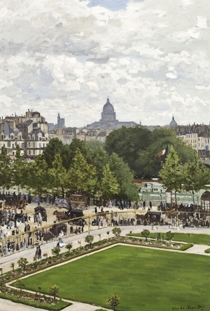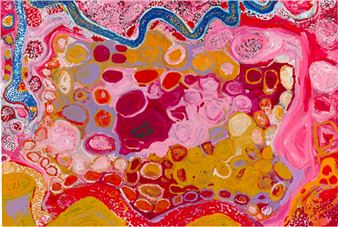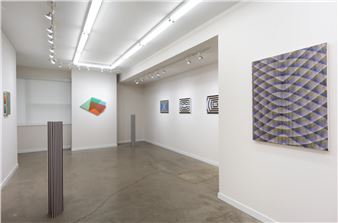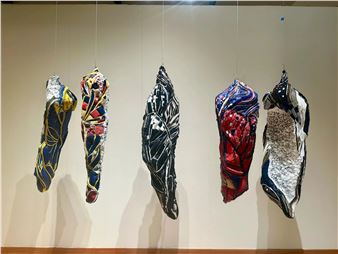Side by Side: Oberlin's Masterworks at the Phillips
The exhibition showcases an unconventional hallmark of The Phillips Collection, the mixing of works of different periods and nationalities in changing installations to reveal new affinities between works of art. This approach reflects the views of museum founder, Duncan Phillips (1886вҖ“1966), who saw the history of art as a conversation through the ages among artists and works of art. In his collection of contemporary art, Phillips included several old masters, including Giorgione, El Greco, and Goya, and an early wish list included the names of others.
Going to the heart of PhillipsвҖҷs claim, among Side by SideвҖҷs loosely themed groupings is one that brings together artists who copied paintings by their predecessors in the Louvre. The AllenвҖҷs Rubens appears with Luncheon of the Boating Party (1880вҖ“81) by Pierre-Auguste Renoir, who is known to have copied works by Rubens. In the second half of his career, after abandoning impressionism, Renoir again looked to Rubens for inspiration. Related works in this section of the exhibition are from the Phillips, by Berthe Morisot, Edgar Degas, and Ferdinand-Victor-EugГЁne Delacroix.
Several works from Oberlin show the world at night: Dovedale by Moonlight (c. 1784вҖ“85) by Joseph Wright of Derby, Pier Francesco MolaвҖҷs Mercury Putting Argus to Sleep (1645вҖ“55), and Giuseppe CesariвҖҷs The Agony in the Garden (Christ on the Mount of Olives) (1597вҖ“98). The moon is the light source in the first two, while ChristвҖҷs angelic vision illuminates the third. Their silvery gleam is reflected in later paintings in the Phillips, including Arthur DoveвҖҷs Me and the Moon (1937) and George InnessвҖҷs Moonlight, Tarpon Springs (1892).
In another group of landscapes, OberlinвҖҷs shimmering View of Venice: The Ducal Palace, Dogana and Part of San Giorgio (1841) by Joseph William Mallord Turner, joins one by his rival John Constable, represented in the Phillips by On the River Stour (1834вҖ“37). Both artists had a powerful effect on modern landscape painting. Their works hang with paintings by Claude Monet, an artist profoundly influenced by Turner. OberlinвҖҷs Garden of the Princess, Louvre (1867) is one of MonetвҖҷs first views of Paris and represents a much earlier stage in his development than The Road to VГ©theuil (1879) and Val-Saint-Nicholas, near Dieppe (Morning) (1897) owned by the Phillips. Other modern landscapes on view in Side by Side include Paul CГ©zanneвҖҷs Viaduct at LвҖҷ Estaque (1882) from Oberlin and add new dimensions to the rich imagery of the south of France, represented at the Phillips by paintings by Pierre Bonnard and Vincent van Gogh.
A display of self-portraits includes one of the most dramatic works on loan from Oberlin. Self-Portrait as a Soldier (1915) by Ernst Ludwig Kirchner expresses the artistвҖҷs terror in the face of war. Kirchner wears the uniform of his artillery regiment, his vacant eyes are pupil-less, and his right hand has been amputated. Nearby are the PhillipsвҖҷs rough-looking CГ©zanne (1878вҖ“80) and OberlinвҖҷs Michiel Sweerts, in which the artist presents himself as a gentleman (1656).
Outside the Rothko Room hang a trio of historic New York School works from Oberlin, by Adolph Gottlieb, Barnett Newman, and Mark Rothko. GottliebвҖҷs The Rape of Persephone and RothkoвҖҷs The Syrian Bull, exhibited in 1943 at the Third Annual Exhibition of Modern Painters and Sculptors, were seized on by critic Edward Alden Jewell in the New York Times as examples of incomprehensible recent art. A few days later, Newman helped Gottlieb and Rothko to draft a rebuttal that set the aesthetic and cultural themes for the New York School. In gratitude, Gottlieb and Rothko gave Newman the two paintings. Side by Side: OberlinвҖҷs Masterworks at the Phillips is organized by The Phillips Collection and the Allen Memorial Art Museum, Oberlin College, Oberlin, Ohio.

Recommended for you
The exhibition showcases an unconventional hallmark of The Phillips Collection, the mixing of works of different periods and nationalities in changing installations to reveal new affinities between works of art. This approach reflects the views of museum founder, Duncan Phillips (1886вҖ“1966), who saw the history of art as a conversation through the ages among artists and works of art. In his collection of contemporary art, Phillips included several old masters, including Giorgione, El Greco, and Goya, and an early wish list included the names of others.
Going to the heart of PhillipsвҖҷs claim, among Side by SideвҖҷs loosely themed groupings is one that brings together artists who copied paintings by their predecessors in the Louvre. The AllenвҖҷs Rubens appears with Luncheon of the Boating Party (1880вҖ“81) by Pierre-Auguste Renoir, who is known to have copied works by Rubens. In the second half of his career, after abandoning impressionism, Renoir again looked to Rubens for inspiration. Related works in this section of the exhibition are from the Phillips, by Berthe Morisot, Edgar Degas, and Ferdinand-Victor-EugГЁne Delacroix.
Several works from Oberlin show the world at night: Dovedale by Moonlight (c. 1784вҖ“85) by Joseph Wright of Derby, Pier Francesco MolaвҖҷs Mercury Putting Argus to Sleep (1645вҖ“55), and Giuseppe CesariвҖҷs The Agony in the Garden (Christ on the Mount of Olives) (1597вҖ“98). The moon is the light source in the first two, while ChristвҖҷs angelic vision illuminates the third. Their silvery gleam is reflected in later paintings in the Phillips, including Arthur DoveвҖҷs Me and the Moon (1937) and George InnessвҖҷs Moonlight, Tarpon Springs (1892).
In another group of landscapes, OberlinвҖҷs shimmering View of Venice: The Ducal Palace, Dogana and Part of San Giorgio (1841) by Joseph William Mallord Turner, joins one by his rival John Constable, represented in the Phillips by On the River Stour (1834вҖ“37). Both artists had a powerful effect on modern landscape painting. Their works hang with paintings by Claude Monet, an artist profoundly influenced by Turner. OberlinвҖҷs Garden of the Princess, Louvre (1867) is one of MonetвҖҷs first views of Paris and represents a much earlier stage in his development than The Road to VГ©theuil (1879) and Val-Saint-Nicholas, near Dieppe (Morning) (1897) owned by the Phillips. Other modern landscapes on view in Side by Side include Paul CГ©zanneвҖҷs Viaduct at LвҖҷ Estaque (1882) from Oberlin and add new dimensions to the rich imagery of the south of France, represented at the Phillips by paintings by Pierre Bonnard and Vincent van Gogh.
A display of self-portraits includes one of the most dramatic works on loan from Oberlin. Self-Portrait as a Soldier (1915) by Ernst Ludwig Kirchner expresses the artistвҖҷs terror in the face of war. Kirchner wears the uniform of his artillery regiment, his vacant eyes are pupil-less, and his right hand has been amputated. Nearby are the PhillipsвҖҷs rough-looking CГ©zanne (1878вҖ“80) and OberlinвҖҷs Michiel Sweerts, in which the artist presents himself as a gentleman (1656).
Outside the Rothko Room hang a trio of historic New York School works from Oberlin, by Adolph Gottlieb, Barnett Newman, and Mark Rothko. GottliebвҖҷs The Rape of Persephone and RothkoвҖҷs The Syrian Bull, exhibited in 1943 at the Third Annual Exhibition of Modern Painters and Sculptors, were seized on by critic Edward Alden Jewell in the New York Times as examples of incomprehensible recent art. A few days later, Newman helped Gottlieb and Rothko to draft a rebuttal that set the aesthetic and cultural themes for the New York School. In gratitude, Gottlieb and Rothko gave Newman the two paintings. Side by Side: OberlinвҖҷs Masterworks at the Phillips is organized by The Phillips Collection and the Allen Memorial Art Museum, Oberlin College, Oberlin, Ohio.
Artists on show
- Adolph Gottlieb
- Arthur Dove
- Barnett Newman
- Berthe Morisot
- Claude Monet
- Edgar Degas
- Ernst Ludwig Kirchner
- Eugène Delacroix
- George Inness
- Giuseppe Cesari
- Hendrick Terbrugghen
- Jan van Eyck
- John Constable
- Joseph Mallord William Turner
- Joseph Wright of Derby
- Mark Rothko
- Michiel Sweerts
- Paul Cézanne
- Pier Francesco Mola
- Pierre Bonnard
- Pierre-Auguste Renoir
- Vincent van Gogh
Contact details


 ARTISTS
ARTISTS














